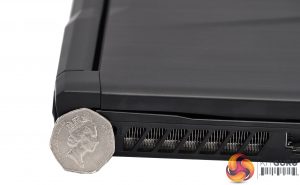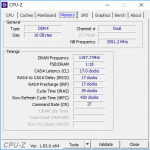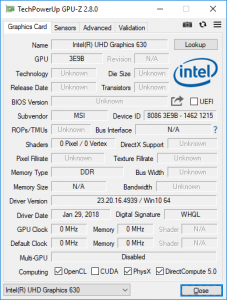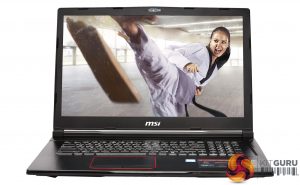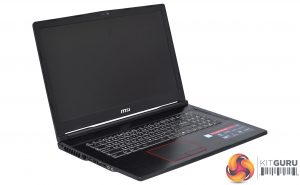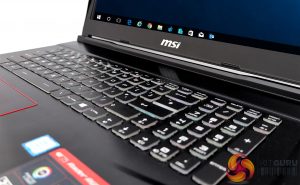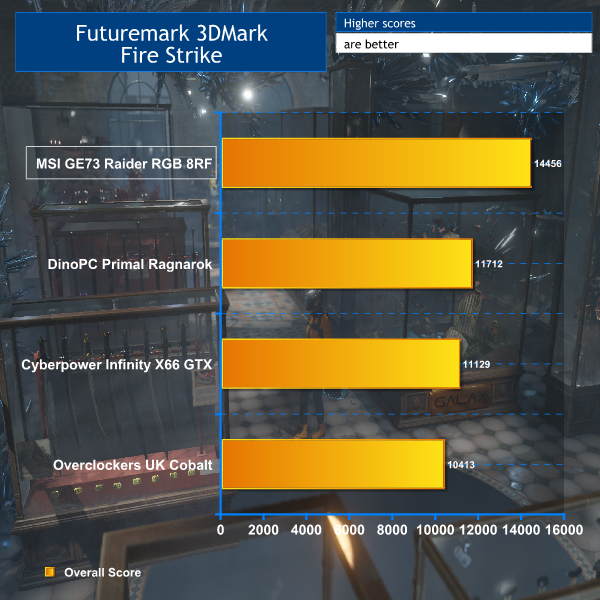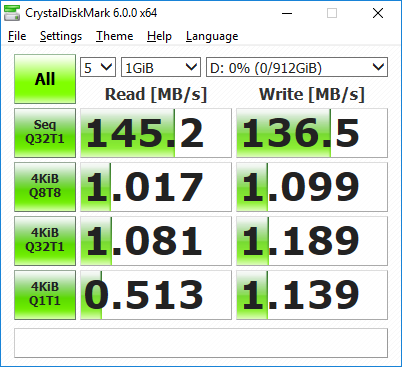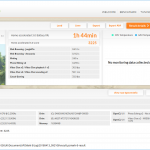
NVIDIA GeForce GTX 1070? Check. Six-core Intel Core i7 running at more than 4GHz? Check. 16GB RAM? Check. Half terabyte SSD and whole terabyte hard disk? Check. This sounds like the perfect specification for a monster gaming tower. But it isn't. These are the main details of the MSI GE73 Raider RGB 8RF, and it's a laptop, not a tower.
This is a pretty hefty beast for a laptop, however. It's a 17.3in model, and weighs in at 2.89kg. It's also a portly 30mm thick. So this is more of a gaming system you can move easily from location to location, rather than a laptop you can game on whilst on the move. This is possible, but you will need quite strong knees, although this is far from the most massive notebook we've seen. It looks positively svelte next to the MSI WT73VR 7RM mobile workstation, for example.
The processor in question is the Core i7-8750H, which has six cores and runs at a nominal 2.2GHz but a single core can hit 4.1GHz. The 16GB of DDR4 memory runs at 2,400MHz. The NVIDIA GeForce GTX 1070 graphics is of course the mobile version, but it's not far behind the desktop version, running at a slightly slower clock but with a few more CUDA cores to compensate.
The MSI GE73 Raider RGB 8RF has one more trick up its sleeve, too, or maybe on its lid and keyboard to be more precise. The clue is in the model name. The lid is attractively illuminated, but the keys can be individually lit with different colours, to help with your finger placement or just to look cool.
With plenty of storage for massive game installs, and a price just north of £2,000 inc VAT, the GE73 Raider RGB 8RF has plenty of potential to be a gaming notebook that could put many desktops to shame, if you have the money. Let's find out if it meets up to the expectation.
System Configuration:
- 2.2GHz Intel Core i7-8750H
- 16GB 2400MHz DDR4 Memory
- 8GB NVIDIA GeForce GTX1070 Graphics
- 17.3in Full HD 120Hz LED backlit TFT
- 512GB Samsung PM871a SATA M.2 SSD
- 1TB HGST Travelstar 7K1000 7,200rpm HDD
- RGB backlit keyboard
- 419.2 x 287.1 x 30.15mm (WxDxH)
- 2.89kg
- Windows 10 64 bit
- 1 year manufacturer’s warranty
Price for this system (at the time of writing): £2,099.99 (inc. VAT)
The MSI GE73 Raider RGB 8RF doesn't arrive in as ostentatious a box as you might imagine. But then it's what's inside that matters.
There's not much in the box, either, other than the hefty power brick and associated mains cable.
Although this is a big notebook, it's not as bulky and bulbous as the largest laptops we've tested. It's definitely a step down in thickness and weight compared to the giant Alienware and Dell XPS 17in and 18in gaming notebooks of yore. But 2.89kg is not a weight you will want to carry about with you just in case you feel like a quick level of Far Cry 5. On the other hand, it does just about fit in a reasonably sized laptop backpack, where fatter notebooks won't.
The predominate theme of the GE73 is black, with just a few flashes of colour in the MSI logo and red line around the trackpad. But then MSI is presumably intending the RGB keyboard lighting to add most of the chromatic interest.
The Intel Core i7-8750H isn't the top member of the current Intel Coffee Lake mobile range. There is, in fact, now a Core i9 member, and the 8750H is the middle of the Core i7 options. But it's still a six-core CPU with Hyper-Threading. The nominal frequency is 2.2GHz, but in reality the processor will rarely run at this speed. A single core can hit 4.1GHz, which will be great for some games, four cores can run at 4GHz, and all six cores can run at 3.9GHz. So it's really a very potent mobile CPU indeed.
The CPU is partnered by a healthy 16GB of 2,400MHz DDR4 memory. That's not as fast as the current desktop speeds, but is still great for a notebook. The memory comes as two SODIMMs, with two slots free for upgrade to the 32GB maximum, although taking the bottom off this notebook isn't meant for end users, according to the “FACTORY SEAL” label on the panel.
As we hinted earlier, the mobile NVIDIA GeForce GTX 1070 is not that far behind the desktop version. In fact, it's almost swings and roundabouts. The basic desktop 1070 runs at a standard 1,506MHz with a 1,683MHz boost, and has 1,920 CUDA cores. The mobile version has a slightly reduced clock running at a standard 1,480MHz with a 1,695MHz boost, but has a greater 2,048 CUDA cores.
The memory allocation and speed are identical, with 8GB of GDDR5 running at 8,000MHz on a 256-bit bus, giving the same 256GB/sec of bandwidth. So overall, there probably won't be that much difference in performance between the two, which is great for a mobile graphics option, particularly when the TDP is 115W rather than 150W for the desktop version.
There's also Intel UHD Graphics 630 from the CPU, which should kick in when the system isn't performing demanding 3D work to reduce power consumption.
The 17.3in screen only offers Full HD (1,920 x 1,080) resolution, and MSI doesn't divulge which panel technology it uses. However, this panel does offer 3ms response times and 120Hz refresh, with a claimed 94 per cent NTSC gamut. The best gaming screens aren't generally the highest resolution, because frame rates trump raw detail, and this screen aims to provide the most fluid motion when playing FPS and racing titles, for example.
The perfect screen would have also had NVIDIA G-Sync and an even lower response. But it's a bright, crisp display with excellent viewing angles (so your friends can watch you play). It's certainly the best notebook screen we've seen for the intended task of providing the most fluid gaming experience possible.
The GE73 is well endowed for storage. There's a decently sized 512GB Samsung PM871a M.2 SSD for the operating system and main software, although it only uses a SATA interface, not the much quicker NVMe. But even this comfortable capacity might fill up quickly now that games take tens of gigabytes each. So it's great that there is also a 1TB HGST Travelstar 7K1000 7,200rpm SATA 2.5in hard disk included as well, which will still be reasonably quick and provides plenty of space for lots of games and other high-volume media content such as video.
The sound is allegedly supplied by a “Giant Speaker” system. This is a bit of an exaggeration, but there is a reasonable amount of bass response for a notebook. The audio quality is still a bit tinny, though. You could share some music with friends in your lounge with sufficient volume, but gamers will usually be wearing headphones anyway.
The 17.3in form factor affords plenty of width for a comfortable keyboard, including a separate keypad. This uses the now virtually universal Chiclet-style design, and the action has a bit more travel than the usual notebook keyboard, which gives it an enjoyably tactile response.
The large trackpad is sensibly placed just about directly beneath the spacebar, rather than centrally for spurious aesthetic reasons. This minimises the chance of accidental mouse movements when typing caused by the heal of your hand, although it doesn't eradicate these completely. It's accurate and smooth, although gamers will almost certainly attach an external mouse when playing. There are two large discrete buttons that are flush with the trackpad itself, but not part of it.
The key feature of the keyboard and trackpad, however, is the per-key RGB lighting system, powered by the SteelSeries Engine 3. By default, this pulses across the spectral range of colour, which is pretty cool in itself. When you press the function key, the keys this affects are highlighted in red whilst the lighting on the others goes off.
The SteelSeries tray icon provides a host of alternative themes, however, with our particular favourite being Disco, which pulses individual keys in a manic fashion that is borderline insane. It's guaranteed to get attention, along the lines of dancing naked in the Vatican. The SteelSeries tray icon also lets you change the lighting for the tick mark-like patterns on the lid (which MSI calls “Mystic Light”), with a similar range of options, including our beloved Disco.
The larger notebook form factors usually allow room for plenty of ports, and the GE73 is reasonably well endowed in this area. The left side is the most well endowed, with headphone and microphone minijacks, USB 3.1 Gen 2 Type C and Type A, Mini DisplayPort, full-sized HDMI, and Gigabit Ethernet. The other side of the air vent is a Kensington lock slot.
The right-hand side merely offers two USB 3.1 Gen 1 (aka USB 3.0) and an SDXC card reader, with the power jack the other side of the air vent.
So, physically this is a solid if not “blingtastic” design, RGB keyboard lighting excepted. Performance is where it's meant to speak most loudly, so let's see how well it does in this respect next.
Since the MSI GE73 Raider RGB 8RF is meant to give gaming desktops a run for their money, we will be testing it against the Overclockers UK Cobalt Overclocked Gaming PC, the DinoPC Primal Ragnarok and Cyberpower Infinity X66 GTX, although not every test is compared to all three systems. The battery test will be compared to a selection of notebooks we have reviewed recently.
Overclockers UK Cobalt Overclocked Gaming PC Specification:
Case: Phanteks Eclipse P300 Glass Midi Tower Case – Black.
Lighting: Phanteks RGB LED Strip Starter Kit.
CPU: Intel Core i3-8350K 4.0GHz (Coffee Lake) Socket LGA1151 Processor (overclocked to 4.8GHz).
Motherboard: ASUS TUF Z370-Plus Gaming Intel Z370 (Socket 1151) DDR4 ATX Motherboard.
CPU Cooling: Alpenfohn Brocken ECO CPU Cooler – 120 mm.
Graphics: ASUS GeForce GTX 1060 Turbo 6144MB GDDR5 PCI-Express Graphics Card.
Memory: Team Group Vulcan T-Force 16GB (2x8GB) DDR4 PC4-24000C16 3000MHz DDR4 Memory.
SSD: 250GB Samsung 850 EVO SSD 2.5in SATA 6Gbps SSD.
HDD: 1TB Seagate BarraCuda 7200rpm SATA HDD.
Power Supply: Cougar VTX 550W 80 Plus Bronze Power Supply.
Operating System: Windows 10 64 bit.
Warranty: 3 Years Warranty – Collect and Return.
Price: £1,234.94 (inc. VAT)
DinoPC Primal Ragnarok Specification:
CPU: AMD Ryzen 5 1600X processor 3.6GHz-4.0GHz
Motherboard: Gigabyte AB350N Gaming WIFI (Socket AM4, 2x DDR4, Mini-ITX)
Memory: 16GB DDR4 2666MHz
Graphics: MSI Radeon RX 580 Armor OC 8GB
CPU Cooler: Corsair Hydro Series H55 Quiet
SSD: Samsung 256GB Polaris PM961 M.2 NVMe PCIe
HDD: Seagate BarraCuda 2TB 3.5″ SATA III
Case: Phanteks Enthoo Evolv ITX Black/Red (No Optical Drive, Mini-ITX)
Power supply: Corsair TX650M 650 Watt 80 Plus Gold Certified PSU
Operating System: Windows 10
Warranty: 5 year Bronze warranty
Price: £1,343 inc VAT.
Cyberpower Infinity X66 GTX Specification:
CPU: Intel Core i5-8600K Coffee Lake Six Core Processor OC 4.3GHz.
CPU Cooler: Cooler Master Seidon 240mm Liquid Cooling.
Motherboard Chipset: MSI Z370-A Pro.
Memory: Adata 16GB (2 x 8GB) 2400MHz DDR4.
Primary Drive: Corsair Force LE200 240GB Solid State Drive.
Secondary Hard Drive: 2TB Seagate Hard Drive 7200rpm 6Gb/s.
Graphics Card: MSI GeForce GTX 1060 6GB.
Power Supply: Cooler Master MasterWatt 600W 80Plus.
Case: In Win 101 Mid Tower w/ Tempered Glass Panel.
Lighting: 1 Red LED on rear fan. Red LED on In Win 101 Logo.
Audio: Onboard 7.1HD Audio.
LAN: Gigabit LAN.
Operating System: Microsoft Windows 10 64Bit.
Price: £1,199 inc VAT.
Tests:
Futuremark 3DMark 2.4 – Fire Strike
Maxon Cinebench R15 – All-core CPU and OpenGL graphics benchmark
Futuremark PC Mark 8 – Battery testing
Crystal DiskMark 6.0 – SSD and HDD transfer rates
Rise of the Tomb Raider – 1920 x 1080, Very High quality
Deus Ex: Mankind Divided – 1920 x 1080, High quality
Futuremark 3DMark
We used 3DMark's ‘Fire Strike' benchmark, which is designed to be used on gaming PCs. We ran the original version only.
Our first hint that the mobile NVIDIA GeForce GTX 1070 graphics are something special comes from the Fire Strike 1.1 score in Futuremark 3DMark. A desktop GTX 1070 will deliver somewhere between 12,000 and 15,000 in the basic Fire Strike, depending on the underlying system, so this notebook is right in the mix, and ahead of all our desktops.
Maxon Cinebench R15
The Maxon Cinebench R15 CPU score really shows how potent the new Coffee Lake Core i7 mobile processor is. It measures up extremely well with the six-core desktop processors we are using for comparison, although these are Core i5 and Ryzen 5 models rather than the desktop Core i7 or Ryzen 7. Still, for a notebook, this is an incredible multi-threaded result.
Rise of the Tomb Raider
We used Full HD (1,920 x 1,080) resolution and graphics set to “Very High” quality with the Rise of the Tomb Raider's built-in benchmark.
The GE73 is clearly outperforming the two systems with NVIDIA GTX 1060 graphics in the Overclockers and Cyberpower systems. It's not far off the AMD Radeon RX 580-sporting DinoPC either. This is an amazing result for a notebook.
Deus Ex: Mankind Divided
We used Full HD (1,920 x 1,080) resolution and graphics set to “High” quality with the Deus Ex: Mankind Divided built-in benchmark. This is a more demanding game than Rise of the Tomb Raider, so using the ‘very high' settings isn't recommended with anything short of a GTX 1080.
The GE73's abilities with Deus Ex: Mankind Divided are even more impressive than with Rise of the Tomb Raider, although we don't have any comparable results from the DinoPC, which would probably have achieved a similar frame rate. Nevertheless, we can safely say that the GE73 will cope with pretty much any current title at its native Full HD screen resolution and high quality settings, and could drive some games at respectable frame rates on an external monitor at 1,440p, although 4K might be a stretch for some titles.
SSD Performance
The Samsung PM871a SSD shows the drawback of its SATA interface. It's a little disingenuous to call 547MB/sec reading and 498MB/sec writing slow, but we're seeing NVMe drives deliver six times this performance now. This is still much faster than a conventional hard disk (see below), and the operating system and software loads quickly enough on this notebook. But we're still waiting to see NVMe SSDs arrive on notebooks in earnest, which will make hibernation mode really fly when you turn the system back on.
HDD Performance
The HGST Travelstar 7K1000 offers 145MB/sec reading and 137MB/sec writing, which is about 40 per cent behind the best desktop 7,200rpm SATA hard disks. But it's pretty quick for a 2.5in mobile SATA drive, and will mean you won't feel too impeded with load times from games installed on this storage device.
Battery Life
We tested the GE73 with Battery Saver turned on, a Balanced power scheme, and a 50 per cent screen brightness, using the PC Mark 8 Home battery test, which runs a series of productivity tasks until the power runs out. For comparison, we include the results from a few other notebooks – the MSI GS40 6QE Phantom, ASUS GL702VT and MSI GT72 2QE Dominator Pro G.
These test scripts don't stress the gaming performance particularly, so this time doesn't represent how long you could play on battery, although there is some 3D activity included. It's supposed to represent a mixture of everyday home user tasks, performed continually.
Battery life could be the GE73's Achilles Heel. It didn't even manage two hours of the PC Mark 8 Home test, which is pretty low compared to our other examples. You will get considerably more than this, maybe more than three hours, of general use that isn't taxing processor and graphics continually.
But this is still a limited amount. The GE73 is clearly a notebook meant to be used tethered to the mains most of the time, with the battery just there for occasional short forays away from the AC power socket.
Acoustic Performance
Acoustic recordings are taken while the system sits at the desktop under minimum load. Then we run 3DMark's FireStrike 1.1 and take the measurements again once the sound has settled to its maximum. All fans were left to the MSI-supplied defaults. We recorded audio from a 1m distance from the base unit at approximately the same level.
The GE73 is pretty quiet, even under load. The fan does audibly fire up once an intensive game has been running for a few minutes, but only to a certain level, and if you're wearing headphones, you won't notice this at all. Even those who are sitting nearby and aren't wearing headphones shouldn't be particularly perturbed.
The MSI GE73 Raider RGB 8RF is a great gaming notebook. You are sacrificing a little on the portability side to achieve gaming performance that will surpass even quite decent desktops. But if you're looking for a laptop you can take to a LAN and not feel at a disadvantage, it fits the bill very nicely indeed.
The new six-core Intel Coffee Lake mobile Core i7 gives you CPU abilities that are on par with all but a premium desktop. Likewise, the mobile NVIDIA GeForce GTX 1070 is providing gaming performance that is pretty much desktop equivalent. Couple that with a built-in screen capable of 120Hz and 3ms response, and you won't even need an external monitor at the LAN.
If we're going to quibble, NVIDIA G-Sync support and 1ms response would have been the icing on the cake. The battery life is the least impressive feature, however, thanks to the bevy of powerful components. Although this notebook is a little more portable than some of the most high-end laptops we've tested, in reality it's still meant to be easily carried from one mains-powered location to another rather than for deathmatches on the move.
It's not exactly cheap, either, with the review specification costing over £2,000 inc VAT, which is nearly twice that of the desktops we used for comparison (although these, of course, don't include screens). But if you're willing to pay the premium for a brilliant notebook gaming experience, you'll get what you paid for with the MSI GE73 Raider RGB 8RF.
Discuss on our Facebook page, over HERE.
Buy from Overclockers UK for £2,099.99 inc vat HERE.
Pros:
- Gaming performance to equal a premium desktop.
- Desktop like six-core CPU performance.
- 120Hz screen with 3ms refresh
- Fun per-key RGB lit keyboard with custom settings.
- Healthy 1.5TB (total) storage.
- Reasonable 16GB of memory.
Cons:
- Expensive.
- Short battery life.
KitGuru says: The MSI GE73 Raider RGB 8RF gives you gaming and CPU performance equal to or better than a decently specified desktop, although it's pricey and the battery life is limited.

 KitGuru KitGuru.net – Tech News | Hardware News | Hardware Reviews | IOS | Mobile | Gaming | Graphics Cards
KitGuru KitGuru.net – Tech News | Hardware News | Hardware Reviews | IOS | Mobile | Gaming | Graphics Cards





